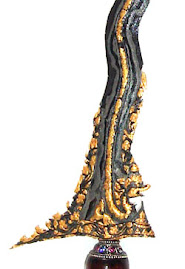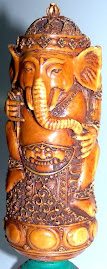
STEP I. PREPERATION FOR MARANGI PROCESS
Marangi is usually done in the month of Sura in the Javanese in the days ot Kliwon Tuesday, Kliwon Friday, Legi Friday, or Legi Tuesday. One day before the procession, the actors of marangi usually fast. In the process of marangi, all actors are to wear Javanese Clothing, restrain eating, drinking, smoking, and talking. These restraints are less practiced these days. The tools for the procession are buckets for clean water, fragrance water, and waste water, brushes, for marangi and whitening, peeled citrus, warangan, coconut oil, 200 cc of krengsengan, 20 cc or more sandalwood oil, bamboo, tissue, rags, and crushed lerak (Sapindus rarak) or detergent as an alternative to lerak.
Citrus are cut into peaces and squeezed with a clean cloth into two containers. One to whiten the tosan aji, and one to dilute warangan. Natural warangan must be pounded before being diluted with citrus. Ususally the proportion is 1 spoon of lerak to 50 cc of citrus. To speed up the dilution, usually base liquids like NaOH/KOH are added or the mixture is heated.
For marangi process, tosan aji should be removed from the sheath and hilt. Keris and spears that are glued with glue can be removed by heating the glue. With clean rag under it, keris should be removed by turning the metal out from the hilt/shaft. If the metal is very rusty, to remove the hilt/shaft, the conjunction is applied with brake fluid and soaked for 24 hours or more. Tosan aji that are extremely rusty are soaked in coconut water with slices of citrus and ripe mengkudu. It should be soaked overnight or more depends on the degree of rust. These processes are done before siraman.
STEP II. MARANGI PROCESS
Marangi is best done in a sunny morning, in a children free house. Best in the terrace of the house. All attributes placed on a carpet. Offerings are placed separately, close to the marangi equipments. Marangi process is best done sitting with crossed legs. The process begins with burning of incense. Then, prayer to God for the wellness of the process and safety. Prayer is also done towards the spirits of empu ancestors so tosan aji will be useful for the owner.
Marangi process goes as follows:
1. Tosan aji is held and poured with water full of flowers. Then, brushed with soap to throw away oil. Then, wiped to dry.
2. Special brush to start whitening. The brush is made out of the horse hair. Brush is dipped to citrus squash, then brush through the blade. Don’t brush two ways, but just one way, from hilt to the end of keris or spears. Leave for a few minutes until the blade turns dark green. Brushing is repeated until rusts are washed away and the iron turns greenish yellow then black. Pour water on to it and brush until the blade turns white like aluminum. Then tosan aji is quickly washed with clean water and wiped with cloth or tissue by pressing on the iron, not wiped. It is then aired to dry.
3. Warangan is thrown over tosan aji. A special brush is used. Take a little and apply to blade one direction a few times. The tip pf the blade is tilted down. This is done a few times and until the iron becomes black. The blade is washed with clean water and brushed until residual acid and warang is washed away. Then tosan aji is cleaned with tissue like in process number 2.
4. The last step is applying oil. It is done after tosan aji is dry or when the blade is put back into the hilt. To preserve the warangan layer, keris should be oiled mildly then aired to dry.












